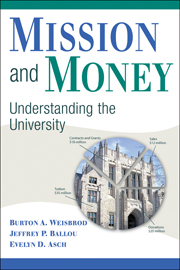Book contents
- Frontmatter
- Contents
- Illustrations
- Preface
- 1 An Introduction to the Higher Education Industry
- 2 The Higher Education Business and the Business of Higher Education – Now and Then
- 3 Is Higher Education Becoming Increasingly Competitive?
- 4 The Two-Good Framework: Revenue, Mission, and Why Colleges Do What They Do
- 5 Tuition, Price Discrimination, and Financial Aid
- 6 The Place of Donations in Funding the Higher Education Industry
- 7 Endowments and Their Management: Financing the Mission
- 8 Generating Revenue from Research and Patents
- 9 Other Ways to Generate Revenue – Wherever It May Be Found: Lobbying, the World Market, and Distance Education
- 10 Advertising, Branding, and Reputation
- 11 Are Public and Nonprofit Schools “Businesslike”? Cost-Consciousness and the Choice between Higher Cost and Lower Cost Faculty
- 12 Not Quite an Ivory Tower: Schools Compete by Collaborating
- 13 Intercollegiate Athletics: Money or Mission?
- 14 Mission or Money: What Do Colleges and Universities Want from Their Athletic Coaches and Presidents?
- 15 Concluding Remarks: What Are the Public Policy Issues?
- Appendix
- References
- Index
13 - Intercollegiate Athletics: Money or Mission?
Published online by Cambridge University Press: 17 July 2009
- Frontmatter
- Contents
- Illustrations
- Preface
- 1 An Introduction to the Higher Education Industry
- 2 The Higher Education Business and the Business of Higher Education – Now and Then
- 3 Is Higher Education Becoming Increasingly Competitive?
- 4 The Two-Good Framework: Revenue, Mission, and Why Colleges Do What They Do
- 5 Tuition, Price Discrimination, and Financial Aid
- 6 The Place of Donations in Funding the Higher Education Industry
- 7 Endowments and Their Management: Financing the Mission
- 8 Generating Revenue from Research and Patents
- 9 Other Ways to Generate Revenue – Wherever It May Be Found: Lobbying, the World Market, and Distance Education
- 10 Advertising, Branding, and Reputation
- 11 Are Public and Nonprofit Schools “Businesslike”? Cost-Consciousness and the Choice between Higher Cost and Lower Cost Faculty
- 12 Not Quite an Ivory Tower: Schools Compete by Collaborating
- 13 Intercollegiate Athletics: Money or Mission?
- 14 Mission or Money: What Do Colleges and Universities Want from Their Athletic Coaches and Presidents?
- 15 Concluding Remarks: What Are the Public Policy Issues?
- Appendix
- References
- Index
Summary
Intercollegiate athletics are no different from any other activity colleges and universities engage in, but are they a revenue activity, a mission activity, or a hybrid of the two?
There is no doubt that they are big business. Attendance for college football and men's basketball exceeds that for the combined National Football League (NFL) and National Basketball Association (NBA) professional teams, and ticket revenue is comparable to that of the NFL (Sandy and Sloane 2004). Athletics can be vital to promoting the goals of many colleges and universities, giving them a particular identity and creating loyalty in students, alumni, area residents, businesses, and donors – loyalty that translates into advertising, student recruitment, and donations. There is also no doubt that intercollegiate athletics – especially football and men's basketball – are expensive and can be distractions from the educational and research missions of the school. In fact, for nearly as long as intercollegiate athletics have been in existence, critics have questioned their role in higher education.
When Harvard College's long-serving president Charles William Eliot criticized commercialism in college sports in 1893, he might have been speaking today, except that the colleges he singled out were those in the Ivy League. He railed against colleges engaging in what we would today call big-time, money-making sports and losing their focus on academic pursuits.
- Type
- Chapter
- Information
- Mission and MoneyUnderstanding the University, pp. 218 - 250Publisher: Cambridge University PressPrint publication year: 2008

